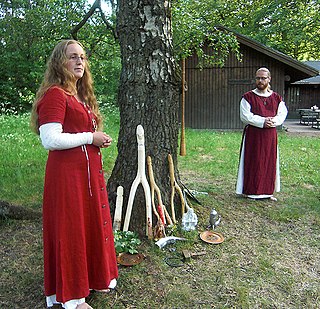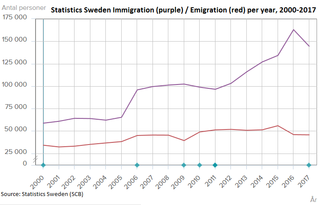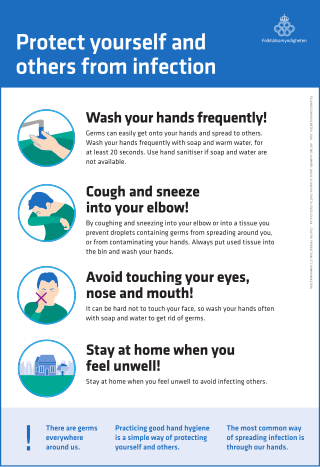The Swedish alphabet is a basic element of the Latin writing system used for the Swedish language. The 29 letters of this alphabet are the modern 26-letter basic Latin alphabet plus Å, Ä, and Ö, in that order. It contains 20 consonants and 9 vowels. The Latin alphabet was brought to Sweden along with the Christianization of the population, although runes continued in use throughout the first centuries of Christianity, even for ecclesiastic purposes, despite their traditional relation to the Old Norse religion. The runes underwent partial "latinization" in the Middle Ages, when the Latin alphabet was completely accepted as the Swedish script system, but runes still occurred, especially in the countryside, until the 18th century, and were used decoratively until mid 19th century.

The Swedish-speaking population of Finland is a linguistic minority in Finland. They maintain a strong identity and are seen either as a separate cultural or ethnic group, while still being considered ethnic Finns, or as a distinct nationality. They speak Finland Swedish, which encompasses both a standard language and distinct dialects that are mutually intelligible with the dialects spoken in Sweden and, to a lesser extent, other Scandinavian languages.

Borlänge is a locality in Dalarna County, Sweden, with 44,898 inhabitants as of 2020. It is the seat of the Borlänge Municipality with a total population of 51,604 inhabitants as of 2017.

The National Defence Radio Establishment is a Swedish government agency organised under the Ministry of Defence. The two main tasks of FRA are signals intelligence (SIGINT), and support to government authorities and state-owned companies regarding computer security.
Social welfare in Sweden is made up of several organizations and systems dealing with welfare. It is mostly funded by taxes, and executed by the public sector on all levels of government as well as private organizations. It can be separated into three parts falling under three different ministries. Social welfare is the responsibility of the Ministry of Health and Social Affairs. Education is the responsibility of the Ministry of Education and Research. The labour market is the responsibility of the Ministry of Employment.

The Community of Forn Sed Sweden, formerly the Swedish Asatro Community is a heathen organization founded in 1994.
The Ministry of Health and Social Affairs is a ministry in the government of Sweden responsible for policies related to social welfare: financial security, social services, medical and health care, health promotion and the rights of children and disabled people.

Immigration to Sweden is the process by which people migrate to Sweden to reside in the country. Many, but not all, become Swedish citizens. The economic, social, and political aspects of immigration have caused some controversy regarding ethnicity, economic benefits, jobs for non-immigrants, settlement patterns, impact on upward social mobility, violence, and voting behaviour.

'De första åren' is a box set by Swedish pop singer and ABBA member Agnetha Fältskog, released in 2004.
Somalis in Sweden are citizens and residents of Sweden who are of Somali ancestry or are Somali citizens. A large proportion of these emigrated after the civil war in Somalia, with most arriving in Sweden after the year 2006.
Gömda is the 1995 literary debut of Swedish author Liza Marklund. It is the first novel in the Maria Eriksson series.

Kristian Olof Erik Gidlund was a Swedish musician and author. He played drums in the rock band Sugarplum Fairy. He hosted Sommar i P1 on Swedish radio and released one book. In 2011 Gidlund was diagnosed with stomach cancer, and died from the disease in 2013 four days short of his 30th birthday.

Anna Carolina Odell is a Swedish artist and film director. She won two Guldbaggen Award for in 2014 for her film The Reunion in the categories Best Film and Best Screenplay. In 2009, her film Okänd, kvinna 2009-349701 received a lot of attention as it includes a faked suicide attempt on Liljeholmsbron in Stockholm. Both films have been nominated and presented at the Venice Biennale Film Festival.
Helene & gänget was a dansband in Kristianstad in Sweden, founded 1990 by members of the Färmarna dansband. The band broke through in 1995 with the album Segla din båt i hamn. The band broke up in 2002 and its singer Helene Persson begun acting as SR Kristianstad programme host. Famous songs recorded by the band are Segla din båt i hamn, En korg med blommor and Nånstans så finns du.

Tino Sanandaji is an Iranian–Swedish economist and author born in Tehran, Iran, who resides in Stockholm, Sweden.
Vulnerable area is a term applied by the Swedish Police Authority to areas with high crime rates and social exclusion. In the December 2015 report, these areas numbered 53. In the June 2017 report, these totalled 61. The increase is reported to be due to better reporting, not a changing situation. The overall trend is that these areas are improving.

The COVID-19 pandemic in Sweden was a part of the pandemic of coronavirus disease 2019 caused by severe acute respiratory syndrome coronavirus 2. As of 22 March 2023, there have been 2,701,192 confirmed cumulative cases and 23,851 deaths with confirmed COVID-19 in Sweden. Sweden ranks 57th in per capita deaths worldwide, and out of 47 European countries, Sweden places 30th. A 2022 estimate of excess mortality during the pandemic using IHME COVID model estimated 18,300 excess deaths during 2020-2021 The Economist model value estimated 13,670 excess deaths between 16th 2020-Mar 6th 2022.

Sweden's unique response to the COVID-19 pandemic has been the subject of significant controversy in both domestic and international circles. Unlike most countries, which strongly recommended or introduced widespread sector closures, quarantining, and lockdown measures to curb the spread of the coronavirus disease 2019, the government of Sweden took a more lenient approach to the pandemic, prioritizing the economy and only pursuing social distancing measures such as bans on large gatherings and limited travel restrictions.
Daniel Olin, is a Finland Swedish talk show produced and broadcast by Finland's national public broadcast company Yle from 2019 to 2022. In the talk show, the host Daniel Olin is visited by a well-known and socially significant person. The conversation focuses on the guest's life, career and personal experiences. The first program was broadcast on 6 April 2019 and the last on 17 April 2022.











